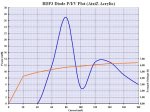I left them on so that i could try them out with different diodes, to see what kind of output they create...
The cube in front of the GGW is a slow axis corrector + prefocuser ..... and is a damn pity that is so long


If only it was just one millimeter long, we can have a perfect focusing tool, just changing the house of the diode in the modules, damn hell ..... but i made some tests, and it's just a pair of millimeters too long for let you use a normal lens assembly for focus the beam in a microscopic extra-burning spot .....
I reached to focus it in a spot maybe 1/10 of the ones that you can reach with a good glass lens assembly, but just dismantling an aixiz glass and using a single lens (and, ofcourse, not using a diode holder, i left the corrector in place on the original diode holder, for the tests)..... and i got a point so tight that it burned white paper powering the led at just 70 mA ..... if only it was thin enough to be fit inside a common aixiz module (AAAARGH !!)
Other than this, they are individually-aligned ..... i mean, the alignment of the SAC axis depend from the position of the chip of the LD when it's in the holder ..... i tried to just put it on the top of a PHR, when i finally dismantled the GGW for put it in a module, but for get the same result, i needed to position it approximatively 1 mm away from the PHR surface, and align it carefully in both axis and rotation ..... i'm not sure that is possible to use them, once you took the original diode away, or at least, it require not-too-easy realignment with the new diode, probably.
Did any BDR-S03's die at as little as 180mA without being pushed much higher first?
I'm sorry, i don't know, cause actually i don't have any of them for test (and, being sincere, i don't have enough money, at the moment, for buy one of them just for destroy it).




